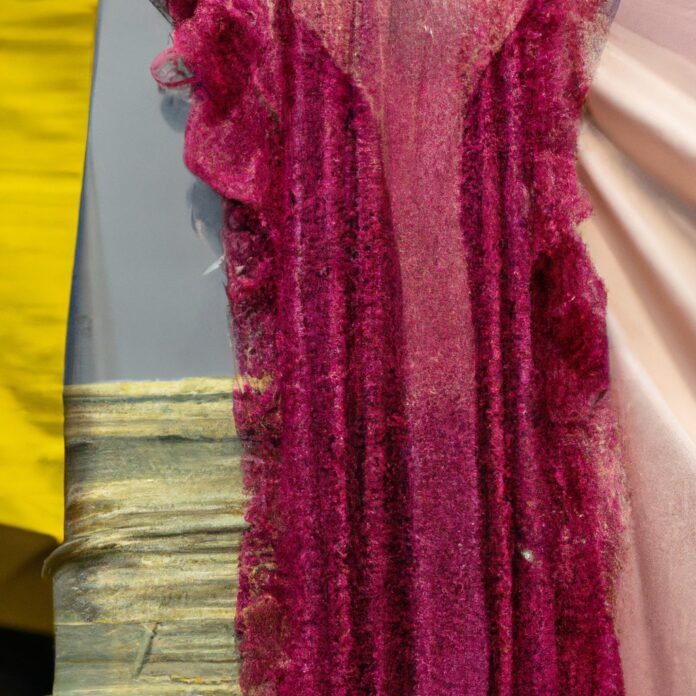Bringing sustainability to the fashion industry may seem like an impossible task, however, sustainable sewing is becoming a prominent DIY couture trend in North America. The values of the sustainable fashion industry are beginning to come to the fore, due to an increasing number of conscientious designers and sewers looking to reduce waste and create ethical products.
1. The North American DIY Revolution: Sustainable Sewing and Couture Trends
Thanks to the North American DIY Revolution, a world of sustainable sewing and couture trends have become accessible to everyone. From bold colors to oversized silhouettes, the possibilities are endless.
Circular Knitting: Circular knitting is a simple yet effective way to recycle clothing knitwear and other fabrics while creating a unique and stylish look. This technique is quickly becoming a popular trend amongst crafters and fashionistas alike, and it is easy to see why. By recycling old materials, creating a circular shape, and perceiving different styles, circular knitting is the perfect way to get creative with sustainable fashion.
Recycled Fabrics: Recycled fabrics are a great way to reduce the environmental impact of the fashion industry by creating something new out of something old. Fabrics like cotton and wool are especially popular because they are easy to work with, make for a great garment, and also tend to be a bit more affordable. Additionally, upcycled fabrics can often be found in thrift stores, giving crafters even more options to find unique materials.
- Vintage fabrics
- Recycled leather
- Organic cotton
- Recycled denim
- Upcycled fabrics
Zero Waste Sewing: Zero waste sewing is the art of creating a garment without producing any fabric waste. This style of sewing is becoming increasingly popular as a way to promote sustainability and reduce the amount of fabric waste sent to landfills. It is also an incredibly creative way to put together a garment from scratch with materials that might otherwise have gone to waste.
Thrifting and Upcycling: Thrifting and upcycling is a great way to reduce the environmental impact of the fashion industry, while also giving clothing a new lease on life. Upcycling can often give older, used items a new look or purpose, and thrifting provides a great way to find unique materials and styles. This is a great option for anyone who wants to practice sustainability and creativity within the fashion industry.

2. Crafting Your Own Eco-Friendly Clothing: Sustainable Sewing Techniques
Choose Reusable Materials
You don’t have to buy new materials to make eco-friendly clothing. Look for fabrics such as:
- Upcycled clothing or textiles
- Organic fabrics and fibres such as hemp and linen
- Vintage and second-hand fabrics
- Motifs from antique fabrics
These materials are perfectly suited to eco-friendly clothing and are more affordable than new fabrics.
Choose the Right Projects
When crafting your own eco-friendly clothing, it’s important to consider the size and complexity of the project. Beginner-friendly projects such as sweaters and t-shirts are a great way to get started. You can also try simple projects such as pillows and scarves.
Consider Durability
When creating eco-friendly clothing, make sure your items will remain durable and long-lasting. Select higher quality fabrics and materials, including interfacing that can help enhance the durability of your pieces. This will help you reduce waste and save resources, as the clothing article can be used for a longer time.
Share Your Craft
Creating eco-friendly clothing is an excellent way to reduce the environmental impact of fashion. But it’s also important to let others know about your unique creations. Share your projects with friends, family or online platforms to inspire others to create their own eco-friendly looks.
Take Care of Your Projects
Once you’ve completed your projects, make sure to take care of them properly. Use a gentle wash cycle for washing and for drying, lay your projects flat. Taking care of your handmade items helps to maintain their longevity so your eco-friendly items can be worn for years.
3. Green Up Your Closet: Trendsetting Sustainable Sewing Ideas
Grab some eco-friendly fabric and let yourself be inspired! There are so many different sustainable fabrics out there, such as organic cotton, Tencel, hemp and bamboo. When shopping for sustainable fabrics, it’s important to read the labels and look for fabrics that have been ethically sourced.
Once you’ve chosen the perfect eco-friendly fabric, you can then start thinking about some creative sustainable sewing ideas. Why not upcycle any old garments you may have lying around the house? It’s a great way to make the most out of your favourite pieces you no longer wear and can help you become more eco-friendly at the same time.
It’s also worth considering using second hand fabrics. Second hand fabrics don’t necessarily have to be old and out-dated. More and more stores are now stocking pre-used fabrics – you can often find designer fabrics or other unique materials in thrift shops.
If you’re looking for something more contemporary, why not try patchworking. This is the perfect way to breathe new life into a selection of different fabrics. And you can make something really unique and special too.
Lastly, why not embrace upcycling. Upcycling is the process of taking an item of clothing and working with it to give it a new use. It’s a great way to put old fabrics to good use and save them from landfill.
- Organic cotton
- Tencel
- Hemp
- Bamboo
4. Crafting a Sustainable Future: North American DIY Couture at the Forefront
Great strides have been made in the fashion industry to promote sustainability through DIY couture. Now, designers in North America are leading the way to a more sustainable future by creating beautiful and unique pieces that require minimal resources. Here’s how:
Upcycling: Upcycling is a fantastic way to reduce waste in the fashion industry. By taking existing clothes and reworking them into something new and inspiring, designers can keep existing pieces out of landfills, while making a fashion statement. This practice also reduces the demand for new products and materials.
Innovative Fabrics: Designers are increasingly using innovative fabrics that use sustainable dyes and are smaller in their carbon footprint. Eco-friendly options like bamboo, lyocell, and organic cotton not only reduce the use of toxic dyes and synthetics, but they also help promote long-term sustainability efforts.
Partnerships: By working with other eco-minded organizations, designers are able to make some truly remarkable pieces. They are often able to draw inspiration from these organizations, and create collections that are both timeless and innovative. This collaboration helps to create a bridge between designers and those who support the environment.
End-to-End Solutions: Designers are increasingly taking a holistic approach to sustainable fashion. By designing pieces that are made out of sustainable materials and crafted with recycled elements, they are able to create both beautiful and sustainably produced garments. Additionally, these pieces are made using locally sourced materials (when possible) to further reduce their environmental impact.
By leveraging these strategies, North American designers are helping to craft a more sustainable future. They prove that sustainability and fashion don’t have to be mutually exclusive, and that’s something we can all be proud of.
From upcycled materials to creative alternatives from natural resources, sustainable sewing is fostering an ethical approach to creating DIY couture in North America. This eco-friendly trend goes beyond practicality and is leading to the fashion world taking important steps towards a greener future.



